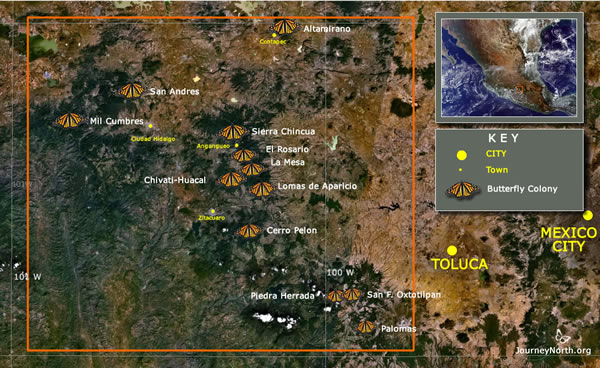Letter from Estela
Sierra Chincua
El Rosario | Sierra Chincua

Sierra Chincua's Koala Colony on April 1, 2017 by Estela Romero
Monarchs Still Clustering at Sierra Chincua! Saturday, April 1, 2017 Dear Friends, At Chincua today, it took 1.45 hrs. to reach the core of the colony walking at a rather quick and non-stopping pace from the entrance of the Sanctuary to the core of the only colony this time, located at “Koala” site, within the Senguio Ejido. One first and interesting observation I wrote down was that at every little water body or natural springs spilling water downhill, there was not a single Monarch drinking water! Why? It was noon time and it could have been the ideal time for them to drink water! It was not that way along the 4 hours we spent walking in the forest. Once my guide Nicolás and I reached the site where the former main colony was at “Koala” Ejido, we could see that only a few Monarchs were left there, a few flying, a few others painting some branches of trees in very light orange.
The first Colony we could still see last week, disappeared and merged with the only Colony now located at about 500 meters down from the site the main colony was last week here at Koala, but being this latter a little uphill than it is now. More and more Monarchs as we walked down told us that there was still a good population remaining. That it was. A still important population is remaining at the Sierra Chincua Sanctuary, to say it so, since, for weeks now, they’ve mainly been settling within the “Koala” Site at the Senguio Ejido, within the Senguio Municipality. With wonderful sunny weather now for days, and really pleasant wind-waves of fresh air, the colony seems to be now perhaps only half the population than last week’s. However, it is still impressive, in spite of being very much spread on one side, but on the other side a mixture of really tiny, to small to only a few medium and perhaps not so dense clusters. Not Monarchs at the tree trunks at all now, but barely some of them trying to stick to one. Mating continues to be very active and perishing seems to be quite normal on the ground, most with evidence of bird predation, and a minor portion of dead bodies as a combination of different perishing facts. When will this remaining part of the population will leave? Nicolás the guide and I agreed that they might be most likely leaving within the week, but, a small portion might be still here next weekend!
I kept thoughtful at Nicolás argument during the rest of the walk on the way back. Could it be possible that Monarchs have left this late in former seasons and none had simply followed them this far? On the way back, as we came back up to the “Casa del Japonés” site, we checked the time in our watches and realized we had already been walking for one exact hour; three quarters of an hour was still left ahead to leave the forest. We met a girl coming from México City with her family to visit the Sanctuary, expressed her not believing she was living a first time in her life experience of being in the forest!!! They said they would reach the colony no matter how far it was! At leaving the Sanctuary, I could feel real nostalgia at turning around and noticing how most of the restaurants and souvenir stores were now totally closed, and only two or three visitors were by one of the two-three restaurants still open. Guides, cooks and most personnel are now gone. Meanwhile, Monarchs are still overwintering at their ease without minding who is left there to come and see them or not!!! None should move! We should all keep quiet waiting for the Queen of Butterflies to decide the final-final leave!!!
|
|
|||||||||||||||
Copyright Journey North (journeynorth.org). All Rights Reserved.




